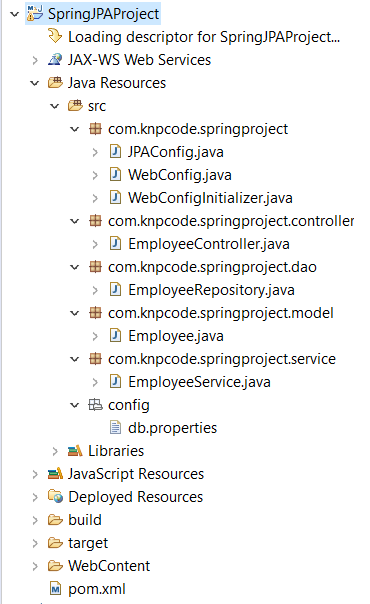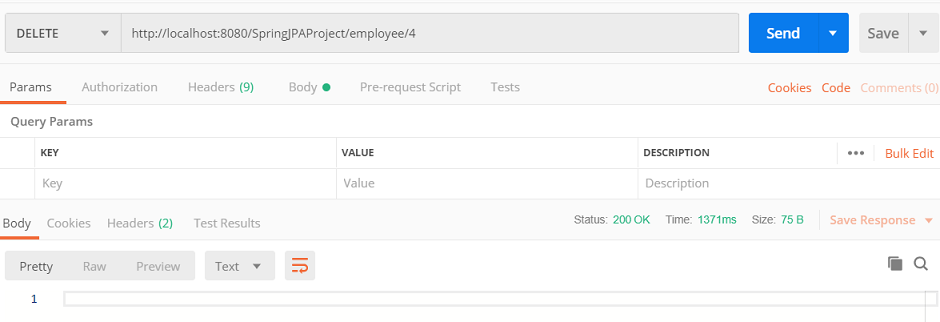In this Spring Data JPA example we’ll create a rest web service using Spring Web MVC, JPA implementation used is Hibernate and DB is MySQL.
Spring Data JPA
Spring data JPA is the Spring Data repository support for JPA.
By using Spring Data repository abstraction on top of the persistence store you are using (JPA, NoSQL, JDBC etc.) you can significantly reduce the amount of boilerplate code required to implement data access layers for those persistence stores.
As a developer you just need to write your repository interfaces, including custom finder methods (if any) and Spring will provide the implementation for those data access methods automatically.
Maven dependencies
<project xmlns="http://maven.apache.org/POM/4.0.0" xmlns:xsi="http://www.w3.org/2001/XMLSchema-instance" xsi:schemaLocation="http://maven.apache.org/POM/4.0.0 http://maven.apache.org/xsd/maven-4.0.0.xsd"> <modelVersion>4.0.0</modelVersion> <groupId>com.knpcode</groupId> <artifactId>SpringJPAProject</artifactId> <version>0.0.1-SNAPSHOT</version> <packaging>war</packaging> <name>SpringJPA</name> <properties> <project.build.sourceEncoding>UTF-8</project.build.sourceEncoding> <spring.version>5.1.8.RELEASE</spring.version> <spring.data>2.1.10.RELEASE</spring.data> <hibernate.jpa>5.4.3.Final</hibernate.jpa> <mysql.version>8.0.17</mysql.version> </properties> <dependencies> <dependency> <groupId>org.springframework</groupId> <artifactId>spring-core</artifactId> <version>${spring.version}</version> </dependency> <dependency> <groupId>org.springframework</groupId> <artifactId>spring-context</artifactId> <version>${spring.version}</version> </dependency> <dependency> <groupId>org.springframework</groupId> <artifactId>spring-webmvc</artifactId> <version>${spring.version}</version> </dependency> <dependency> <groupId>org.springframework</groupId> <artifactId>spring-web</artifactId> <version>${spring.version}</version> </dependency> <!-- Spring data JPA --> <dependency> <groupId>org.springframework.data</groupId> <artifactId>spring-data-jpa</artifactId> <version>${spring.data}</version> </dependency> <dependency> <groupId>com.fasterxml.jackson.core</groupId> <artifactId>jackson-databind</artifactId> <version>2.9.6</version> </dependency> <dependency> <groupId>javax.servlet</groupId> <artifactId>javax.servlet-api</artifactId> <version>4.0.0</version> <scope>provided</scope> </dependency> <!-- Hibernate --> <dependency> <groupId>org.hibernate</groupId> <artifactId>hibernate-entitymanager</artifactId> <version>${hibernate.jpa}</version> </dependency> <!-- MySQL Driver --> <dependency> <groupId>mysql</groupId> <artifactId>mysql-connector-java</artifactId> <version>${mysql.version}</version> </dependency> <dependency> <groupId>org.slf4j</groupId> <artifactId>slf4j-api</artifactId> <version>1.7.25</version> </dependency> </dependencies> <build> <sourceDirectory>src</sourceDirectory> <plugins> <plugin> <artifactId>maven-compiler-plugin</artifactId> <version>3.8.0</version> <configuration> <release>11</release> </configuration> </plugin> <plugin> <artifactId>maven-war-plugin</artifactId> <version>3.2.1</version> <configuration> <warSourceDirectory>WebContent</warSourceDirectory> </configuration> </plugin> </plugins> </build> </project>
Dependencies are added for Spring core, Spring context as well as for Spring Web and Spring data JPA.
Dependency for Hibernate is added as Hibernate JPA implementation is used.
MySQL connector is used for connecting to MySQL DB from Java application.
Jackson databind is needed for webservice responses which are sent as JSON.
Project structure
Project structure with full implementation of this Spring Data JPA example is as follows-
DB table Query
MySQL DB table used for this Spring data JPA can be created using the following query.CREATE TABLE `emp` ( `id` int(11) NOT NULL AUTO_INCREMENT, `first_name` varchar(45) DEFAULT NULL, `last_name` varchar(45) DEFAULT NULL, `department` varchar(45) DEFAULT NULL, PRIMARY KEY (`id`) ) ENGINE=InnoDB DEFAULT CHARSET=utf8;
Spring Data JPA example – Model class
import javax.persistence.Column; import javax.persistence.Entity; import javax.persistence.GeneratedValue; import javax.persistence.GenerationType; import javax.persistence.Id; import javax.persistence.Table; @Entity @Table(name="emp") public class Employee { @Id @GeneratedValue(strategy = GenerationType.IDENTITY) private int id; @Column(name="first_name") private String firstName; @Column(name="last_name") private String lastName; @Column(name="department") private String dept; public int getId() { return id; } public void setId(int id) { this.id = id; } public String getFirstName() { return firstName; } public void setFirstName(String firstName) { this.firstName = firstName; } public String getLastName() { return lastName; } public void setLastName(String lastName) { this.lastName = lastName; } public String getDept() { return dept; } public void setDept(String dept) { this.dept = dept; } @Override public String toString() { return "Id= " + getId() + " First Name= " + getFirstName() + " Last Name= " + getLastName() + " Dept= "+ getDept(); } }
This is the model class which corresponds to the emp table in DB.
@Entity annotation specifies that this model class is an entity.
@Table annotation specifies the primary table for the entity.
@Id annotation specifies the primary key of the entity.
@GeneratedValue specifies the primary key generation strategy which is autoincrement in this case.
@Column annotation specifies the mapped table column name for the field.
Spring Data JPA example – Repository
import java.util.List; import org.springframework.data.repository.CrudRepository; import com.knpcode.springproject.model.Employee; public interface EmployeeRepository extends CrudRepository<Employee, Integer> { List<Employee> findByLastName(String lastName); }
EmployeeRepository interface extends CrudRepository which takes the domain class to manage (Employee in this case) as well as the id type of the domain class as type arguments.
That is all the data access code you need for your CRUD functionality, no need to write a class that implements this interface.
The CrudRepository which is inherited by your custom repository provides sophisticated CRUD functionality for the entity class that is being managed. Some of the methods that are in the CrudRepository interface.
- <S extends T> S save(S entity)- Saves the given entity.
- T findOne(ID primaryKey)- Returns the entity identified by the given id.
- Iterable<T> findAll()- Returns all entities.
- Long count()- Returns the number of entities.
- void delete(T entity)- Deletes the given entity.
- boolean exists(ID primaryKey)- Indicates whether an entity with the given id exists.
You can also write custom queries which can be generated automatically or you can write the query as Named query or by using @Query annotation with in the repository. As you can see in our Repository interface there is a findByLastName() method. For methods starting with such names as “find”, “count”, “remove”, “delete”, Spring framework, by parsing the method name and matching it with a property in the entity class can automatically generate the correct query.
See example of using @NamedQuery annotation in Spring Data JPA in this post- Spring Data JPA @NamedQuery Annotation Example
See example of using @Query annotation in Spring Data JPA in this post- Spring Data JPA @Query Annotation Example
Spring Data JPA example – Service class
From the service layer we’ll call the DAO layer methods. Since all we need is a repository in case of spring data so we’ll call methods of repository from the service class. Notice that repository instance has to be injected in the service class.
import java.util.List; import org.springframework.beans.factory.annotation.Autowired; import org.springframework.stereotype.Service; import com.knpcode.springproject.dao.EmployeeRepository; import com.knpcode.springproject.model.Employee; @Service public class EmployeeService { @Autowired private EmployeeRepository repository; public Employee getEmployeeById(int id) { return repository.findById(id).get(); } public List<Employee> getAllEmployees(){ return (List<Employee>) repository.findAll(); } public void deleteEmployeeById(int id){ repository.deleteById(id); } public Employee addEmployee(Employee emp) { return repository.save(emp); } public List<Employee> getEmployeeByLastName(String lastName) { return repository.findByLastName(lastName); } }
Spring Data JPA example – Controller class
Using a Rest controller class we’ll map the path to the methods that are to be called for the requests.
import java.util.List; import org.springframework.beans.factory.annotation.Autowired; import org.springframework.http.HttpStatus; import org.springframework.web.bind.annotation.DeleteMapping; import org.springframework.web.bind.annotation.GetMapping; import org.springframework.web.bind.annotation.PathVariable; import org.springframework.web.bind.annotation.PostMapping; import org.springframework.web.bind.annotation.RequestBody; import org.springframework.web.bind.annotation.RequestMapping; import org.springframework.web.bind.annotation.ResponseStatus; import org.springframework.web.bind.annotation.RestController; import com.knpcode.springproject.model.Employee; import com.knpcode.springproject.service.EmployeeService; @RestController @RequestMapping("/employee") public class EmployeeController { @Autowired EmployeeService empService; @GetMapping("/{id}") public Employee getEmployeeById(@PathVariable int id) { return empService.getEmployeeById(id); } @GetMapping public List<Employee> getAllEmployees(){ return empService.getAllEmployees(); } @DeleteMapping("/{id}") @ResponseStatus(HttpStatus.OK) public void deleteEmployeeById(@PathVariable int id){ empService.deleteEmployeeById(id); } @PostMapping @ResponseStatus(HttpStatus.CREATED) public Employee addEmployee(@RequestBody Employee emp) { return empService.addEmployee(emp); } @GetMapping("/lastname/{lastName}") public List<Employee> getEmployeeByLastName(@PathVariable String lastName) { return empService.getEmployeeByLastName(lastName); } }
Spring Data JPA example – Configuration
In this Spring data JPA example Java configuration is used so class is annotated with @Configuration annotation.
For setting up DataSource, DB properties are read from a properties file. Path for the properties file is configured using @PropertySource annotation.
@EnableJpaRepositories annotation enables the JPA repositories. Package to scan for the repositories is provided as a value with this annotation.
@EnableTransactionManagement annotation enables Spring's annotation-driven transaction management capability.
With in this Java config class we set up a EntityManagerFactory and use Hibernate as persistence provider.
import java.util.Properties; import javax.sql.DataSource; import org.springframework.beans.factory.annotation.Autowired; import org.springframework.context.annotation.Bean; import org.springframework.context.annotation.Configuration; import org.springframework.context.annotation.PropertySource; import org.springframework.core.env.Environment; import org.springframework.data.jpa.repository.config.EnableJpaRepositories; import org.springframework.jdbc.datasource.DriverManagerDataSource; import org.springframework.orm.jpa.JpaTransactionManager; import org.springframework.orm.jpa.LocalContainerEntityManagerFactoryBean; import org.springframework.orm.jpa.vendor.HibernateJpaVendorAdapter; import org.springframework.transaction.PlatformTransactionManager; import org.springframework.transaction.annotation.EnableTransactionManagement; @Configuration @EnableJpaRepositories("com.knpcode.springproject.dao") @EnableTransactionManagement @PropertySource("classpath:config/db.properties") public class JPAConfig { @Autowired private Environment env; @Bean public LocalContainerEntityManagerFactoryBean entityManagerFactory() { HibernateJpaVendorAdapter vendorAdapter = new HibernateJpaVendorAdapter(); LocalContainerEntityManagerFactoryBean factory = new LocalContainerEntityManagerFactoryBean(); factory.setJpaVendorAdapter(vendorAdapter); factory.setPackagesToScan("com.knpcode.springproject.model"); factory.setDataSource(dataSource()); factory.setJpaProperties(hibernateProperties()); return factory; } @Bean public DataSource dataSource() { DriverManagerDataSource ds = new DriverManagerDataSource(); ds.setDriverClassName(env.getProperty("db.driverClassName")); ds.setUrl(env.getProperty("db.url")); ds.setUsername(env.getProperty("db.username")); ds.setPassword(env.getProperty("db.password")); return ds; } Properties hibernateProperties() { Properties properties = new Properties(); properties.setProperty("hibernate.dialect", env.getProperty("hibernate.sqldialect")); properties.setProperty("hibernate.show_sql", env.getProperty("hibernate.showsql")); return properties; } @Bean public PlatformTransactionManager transactionManager() { JpaTransactionManager txManager = new JpaTransactionManager(); txManager.setEntityManagerFactory(entityManagerFactory().getObject()); return txManager; } }
If you are using XML configuration then the configuration for enabling JPA repositories is-
<jpa:repositories base-package="com.knpcode.springproject.dao"/>db.properties file
db.driverClassName=com.mysql.cj.jdbc.Driver db.url=jdbc:mysql://localhost:3306/knpcode db.username= db.password= hibernate.sqldialect=org.hibernate.dialect.MySQLDialect hibernate.showsql=true
To set up the web application using Java config rather than using the web.xml we’ll need the following classes.
import org.springframework.web.servlet.support.AbstractAnnotationConfigDispatcherServletInitializer; public class WebConfigInitializer extends AbstractAnnotationConfigDispatcherServletInitializer { @Override protected Class<?>[] getRootConfigClasses() { // TODO Auto-generated method stub return null; } @Override protected Class<?>[] getServletConfigClasses() { return new Class<?>[] {WebConfig.class}; } @Override protected String[] getServletMappings() { return new String[] {"/"}; } }
@Configuration @EnableWebMvc @ComponentScan(basePackages = "com.knpcode.springproject") public class WebConfig implements WebMvcConfigurer{ }
Deploying the Spring Data JPA application
Right clicking the project and select Run As – Maven build, provide goal as clean install. If the build is successful you will have your application packaged as a war which you can deploy on web container like Tomcat and then test the application.
For testing the RESTful webservice, Postman rest client is used.
Adding employee
Note that the request selected is POST and the URL is http://localhost:8080/SpringJPAProject/employee
Data is sent as request body in JSON format. In the response added Employee data is sent back.
Get All employees
Delete Employee by ID
Get Employee by last name
You can also also send requests directly from browser as done for this request.That's all for the topic Spring Data JPA Example. If something is missing or you have something to share about the topic please write a comment.
You may also like





No comments:
Post a Comment